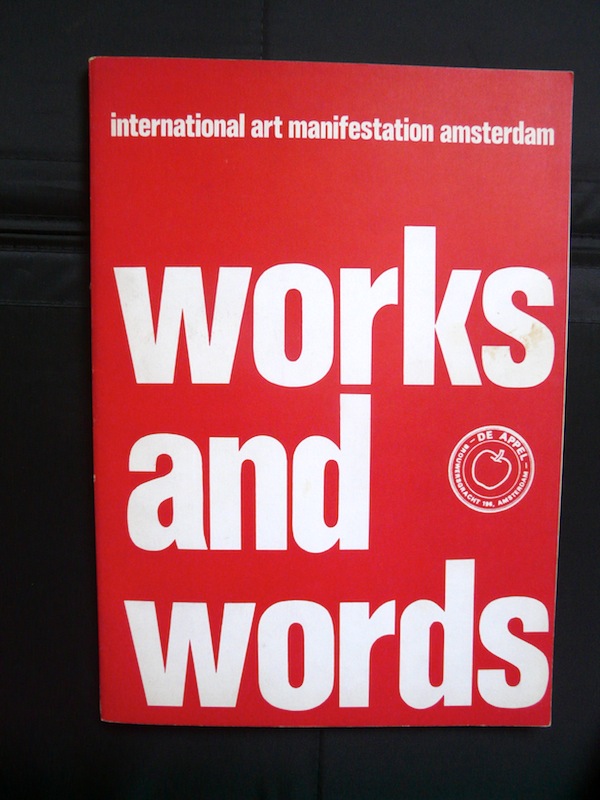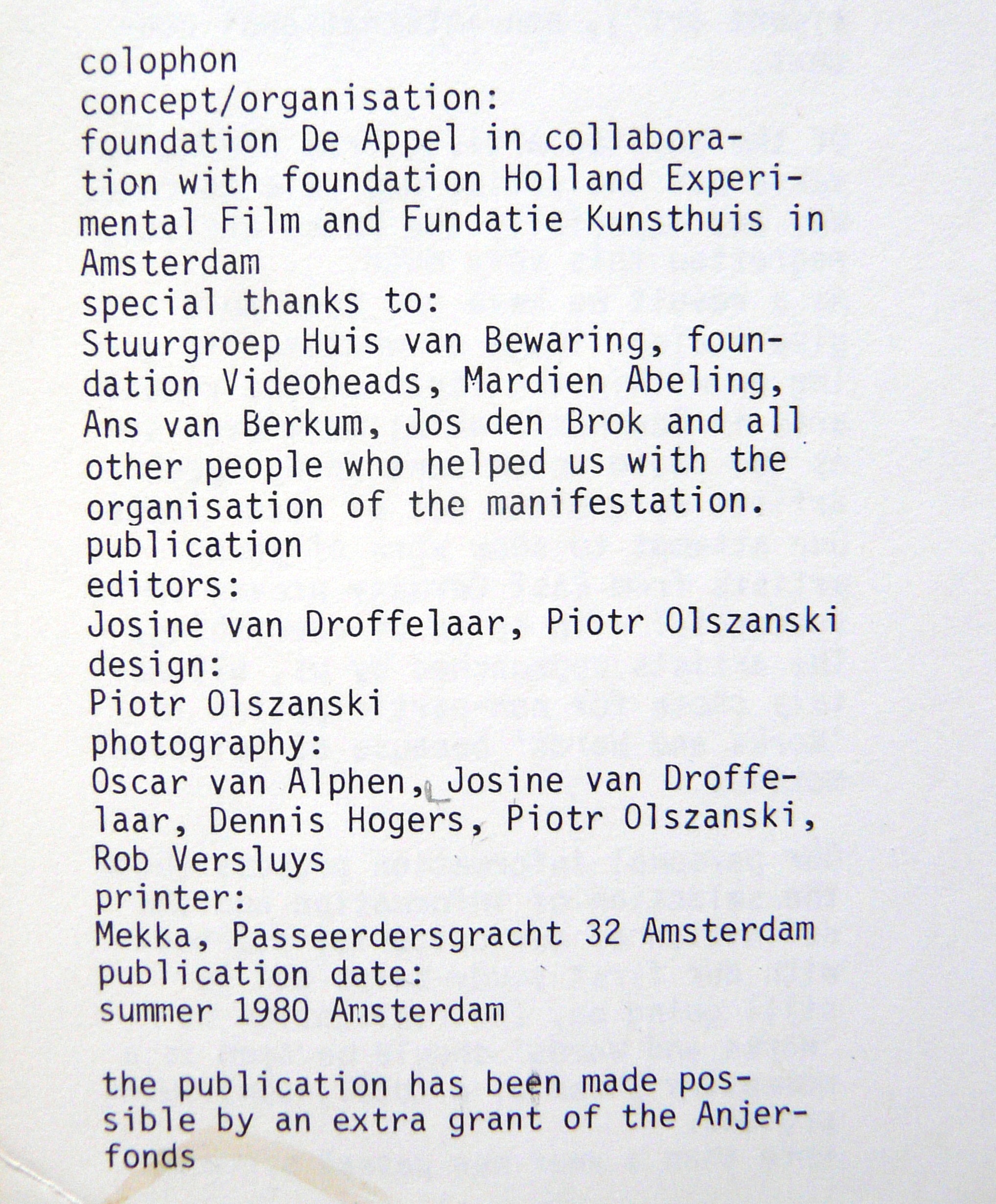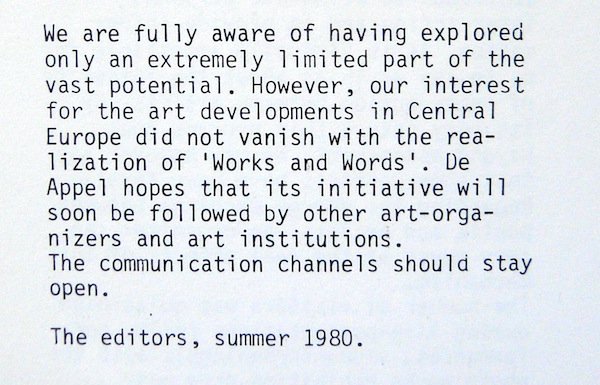Works and Words – Early critiques of the discourse of Eastern European Art
The exhibition Works and Words, organized in Amsterdam’s De Appel Foundation, in the words of it’s organizers aimed at “creating confrontation between artists who share a common sensibility from Hungary, Czechoslovakia, Poland, Yugoslavia and the Netherlands. It was a manifestation which focused on the dialectical interaction of reflection and action, of works and words”.[1] The exhibition program and information on participants can be found in the original leaflet attached here, while De Appel archive provides a short description, accompanied by several images and videos.
At the first glance, Works and falls out of the story on different aesthetical-political positions and trajectories of New Art in Student Cultural Center – Belgrade (SKC), which is the main theme of the selection of projects presented in this archive. The exhibition, presented in 1979, approaches this field of observation laterally, as it has to do with the various developments (’the works and words’) of certain artists and critics from former Yugoslavia [2] who participated in the program of SKC or who were broadly connected with the SKC ideosphere [3].
However, what is more interesting within the context of this archival presentation is that the participation of Yugoslav Artists – and protagonists of SKC scene in particular – had intervened within the conceptual framework of exhibition-in-the-process-of-making. The exhibition was initially conceived as presentation of Eastern European Art, as an event that accumulates its curiousness in the very fact that it presents the art from ‘behind the Iron Curtain’, as ‘something that is rarely seen abroad’, thus offering the presentation context that ‘covers’ the reality of singular artworks by grouping them behind the monolithic banner of dissident art. Some of the artists gathered around the SKC gallery expressed their disagreement with such idea of presentation. They perceived it as an act of ‘closing particular works by individual artists into an uniform ghetto’, and requested more equality with the Western art context by problematizing its ‘exclusive’ right to recognition of singular artistic positions. Goran Đorđević, who used to exhibit in SKC from 1973-1985[4], wrote to exhibition organizers about how such an international context of exhibiting, based on the mimicry of the cold-war geopolitical agenda, actually becomes the only context of presentation on offer for the artists coming from Eastern Europe. Đorđević’s answer to invitation letter summarized some of the critiques coming from the side of Yugoslav participants: “They (The artists from Eastern Europe) are practically forced to accept any offer since these are rare occasions when their work has a recognized artistic status, and on the other hand, this exhibition should explicitly or implicitly reaffirm the ‘unlimited’ freedom of artistic activities and ‘universality’ of cultural/artistic practice of the West. In that way the significance of such ‘ghetto’ exhibition is mainly reduced to its political dimension (dissident, exotic), while the nature of the works themselves, their character and significance, are pushed to background.”[5] After receiving Đorđević’s letter, the exhibition curators changed the initial plan; they decided to avoid framing the exhibition within the expected geopolitical agenda and joined the previously separated group of artists from Netherlands to the general selection; they also have chosen the more ‘universal’ heading – Works and Words – as the exhibition title, and dropped the term of “East European” that was prominent in previous versions and propositions. The answer by curator Josine van Droffelaar is included in the photo selection of this article, while the letter by Đorđević is reproduced among archival documents.
The story behind the exhibition Works and Words is an interesting example, or a comment on the contemporary forms of representation of Eastern Europen art in the (former) West. This story announced in a way the re-introduction of the critique of the discourse of Eastern European art in theoretical and art-historical overviews of the exhibition history and art history that emerged after 1989. As for the generation of artists gathered around SKC gallery in the 1970s, the exhibition can be observed as the indicator of some of their positions towards the “outside”, towards the context of international presentation and participation in the politics of exhibiting and framing New Art in the European and global context.
c.f. curatorial-editorial introduction text, Works and Words (exhibition catalog), De Appel 1980.
i.e. Marina Abramović, Biljana Tomić, Vladimir Gudac, Ješa Denegri, Raša Todisijević, Goran Đorđević, Tomislav Gotovac, Vladimir Gudac, Sanja Iveković, Marijan Susovski, Dalibor Martinis etc.
The term Ideosphere is borrowed from the same-titled text by Rolan Barthes. Here in particular ‘SKC ideosphere’ refers to the institutional links between the Student Centers in Belgrade, Zagreb and later Ljubljana, and their various other official or self-organised art spaces supporting the work of young artists; it also refers to the personal relations and friendships among different artists, art groups or art couples living and working in various cities throughout Yugoslavia.
Goran Đorđević leaves the artworld as individual artists in 1985, or – to term it in his own words – he ‘disappears as a character from the artistic scene’.
From Đorđević’s letter to the organisers of the exhibition Works and Words.
Date: 20-30 September 1979
Location: De Appel Foundation, Amsterdam
Curators: Frank Gribling, Josine van Droffelaar
Participating artists and critics: Aalders Franklin, Abramovic Marina, Andel Jaroslav, Attalai Gabor, Bartos Peter, Belic Zoran, Beres Jerzy, Body Gabor, Cardena Warming Up…., Demur Boris, Denegri Jesa, Djordjevic Goran, Nusa & Sreco Dragan, Durcek Lubomir, Dziamski Grzegorz, Erdely Miklos, Galeta Ladislav, Gotovac Tomislav, Antje von Graevenitz, Gribling Frank, Grinberg Bucky, Gudac Vladimir, Hajas Tibor, Haka Janusz, Halasz Karoly, Havrilla Vladimir, Hawley Martha, Hay Agnes, Hegyi Lorand, Hoover Nan, Ivekovic Sanja, Jenssen Servie, Jaworski Cezary, Jovanovics Gyorgy, Jozwiak Jacek, Karolyi Zsigmond, Kelemen Karoly, Kern Michal, Knizak Milan, Koller Julius, Konart Tomasz, Kostovowski Andrzej, Kovanda Jiri, Harrie de Kroon, Kutera Romuald, Kwiek Pawel, Kwiek Przemyslaw & Kulik Zofia, Lachowicz Andrzej, Leering Jean, LL Natalia, Marroquin Raul, Martinis Dalibor, Maurer Dora, Mikolajcick Antoni, Miler Karel, Mlcoch Jan, Mrozek Lech, Murak Teresa, Paruzel Andrzej, Peeters Sef, Pinczehelyi Sandor, Pogacnic Marco, Reindeer Werk, Richter Jaroslav, Robakowski Jozef, Sikorski Tomasz, Sosnowski Teresa / Zdzislaw, Stilinovic Mladen, Stembera Petr, Straus Tomas, Susovski Marijan, Szczerek Janusz, Sziranyi Istvan, Todosijevic Rasa, Tomic Biljana, Tot Endre, Ulay, Valoch Jiri, Veto Janos, Warpechowski Zbigniew, Wasko Ryszard, Albert van der Weide, Zarebski Krzysztov, Zbornik Dobra.





